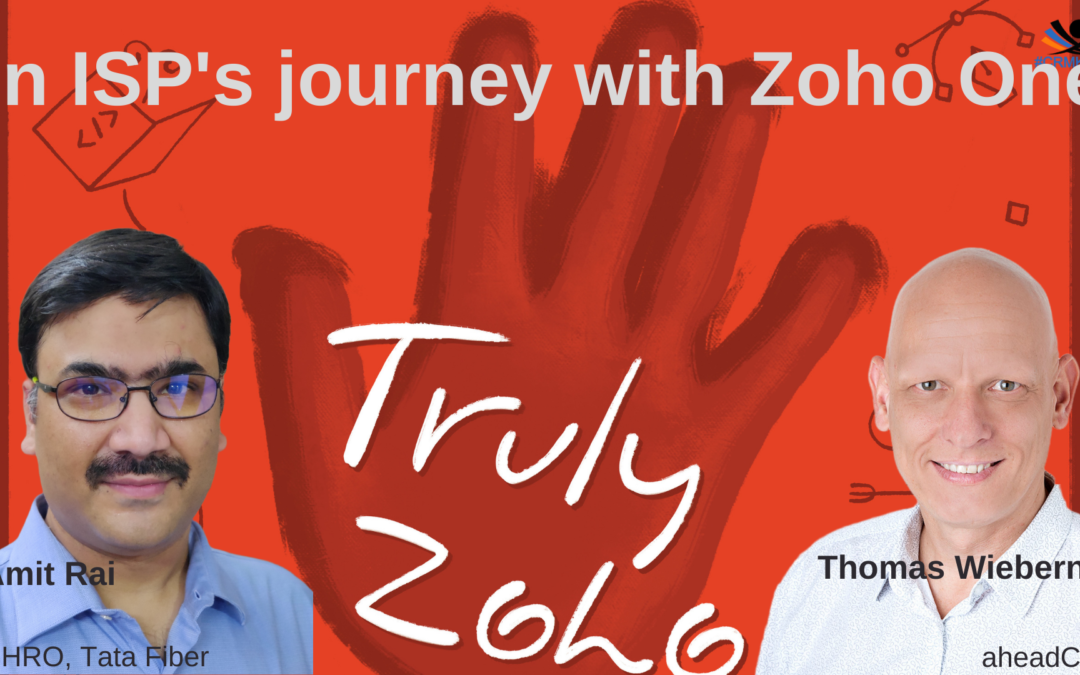
by twieberneit | Mar 21, 2023 | Blog, Case Study |
During the truly remarkable (pun definitely intended) TrulyZoho event I, of course had the chance to talk to some customers. One of these customers was Amit Rai of Tata Fiber, an Indian ISP. As the name suggests, Tata Fiber provides internet services through fiber. The company was founded in 2016 and started commercial rollout in 2018, so is a kind of start-up. Amit is the Chief HR Officer of Tata Fiber, but also led their digital projects and is now heading business development for the company. He happily agreed to a conversation about the relationship between Zoho and Tata. The following article is based on the conversation with Amit. TL&DR If you do not want to read and prefer a video, you can also listen in to the conversation. The original problem at hand We started in 2019 with HR management, in particular with Zoho people, as a solution in this functional area was needed. The implementation gave us confidence in Zoho and our implementation partner. From there on we implemented additional Zoho apps. We started on the call center as the agents needed to work with and toggling between a multitude of screens when working with a customer to resolve issues. The agents in parallel needed to talk to the customer, making sense. Of course, the quality of the conversations suffered from this and the conversations got longer. Longer conversations are a cost to us. Why Zoho? The original implementation gave us a good confidence in Zoho. This was not only because of the product but also because of the responses from the Zoho organization and the implementation team, the...

by twieberneit | Sep 5, 2022 | Blog |
It is time for a stake in the ground again. Of late, every vendor who used to play in the CRM arena positions itself as a „customer experience“ player and claims that its software “delivers customer experiences”. This is quite a claim. It also raises a lot of important questions. What is “customer experience”? And who is responsible for it? How does “customer experience” differ from “customer experiences”? What is the difference to customer engagement? How do they relate to customer expectations? And then there is “customer success”, too. What about customer satisfaction? Finally, how does CRM fit into the picture? As you can see, there is a lot of scope for confusion. And this confusion has definitely materialized. So, let’s start with some definitions Friend and industry luminary Paul Greenberg has ventured here already back in 2015 (and before). Still, as time moves, the industry evolves, and things tend to get forgotten, let me take another stab at it. The more fundamental concepts are perhaps engagement, followed by customer expectation and customer success. You can also watch my take on customer engagement vs. customer experience in this 90 second video. Customer engagement According to Merriam-Webster, engagement is “the act of engaging” or “the state of being engaged”. Well, let’s look at the verb, then. Amongst some other meanings, engage is defined as “attract and hold by influence or power” or “induce to participate”. So, engagement is essentially about interacting with each other. This is usually mutual, but mandatorily involves communication, reaching out, by the company. Importantly, this engagement can also happen the product or service itself, for instance...

by twieberneit | Aug 22, 2022 | Blog |
Customer success has become an interesting topic for software vendors and systems integrators, alike. I am thinking about this topic for a while now and now bring my thoughts to virtual paper after Jon Reed pinged me about it and after reading Josh Greenbaum’s very readable post about “customer successing”. By the way, Jon called software vendors to attention and to deliver proof points in a great article, too. So, call me a copycat 😉. The customer success movement In the past years enterprise software vendors and consultancies alike, have increasingly established customer success teams as part of their organizations. One can almost call it a movement. And it is a laudable endeavor to work on ensuring the customers’ success. However, when looking closer at the reasons for their establishment and their charters, it becomes quite obvious that many of these customer success teams are set up as a reaction to failing implementation projects or, even worse, as a vehicle for selling further services to customer companies. Consequently, metrics that are used for measuring the success of the customer success teams are based around project metrics. Have implementation projects been on time, in budget, and delivered quality results, means they have been successful. Don’t get me wrong: there is nothing wrong with attempting to improve project success and to generate additional sales. There are still woefully many projects that do not get implemented within the allotted budget and time, and in sufficient quality. Additionally, one can argue that only happy customers do follow-up purchases; and customers are happy because the earlier projects succeeded. I get it. Seriously. I am a consultant, too. Many vendors, often...




